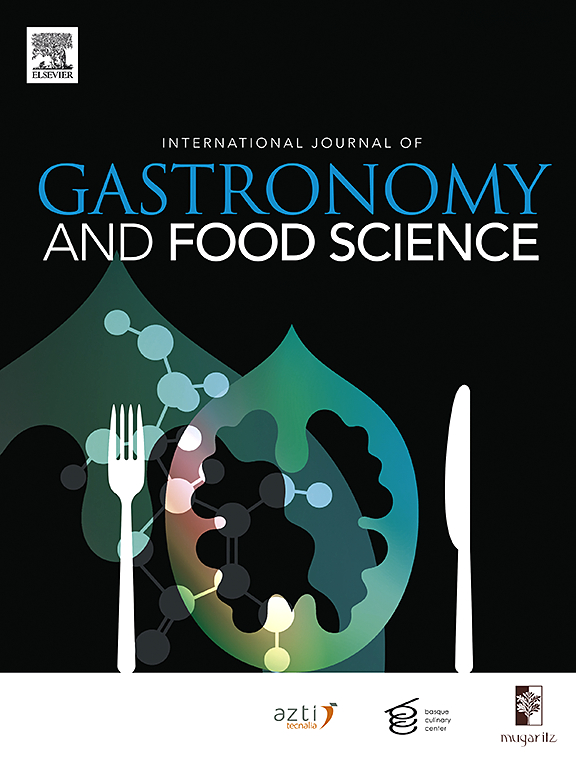New dimensions in dining: A review of the gastronomic evolution of 3D printed foods from 2013 to 2024 and beyond
IF 3.2
2区 农林科学
Q2 FOOD SCIENCE & TECHNOLOGY
International Journal of Gastronomy and Food Science
Pub Date : 2024-10-01
DOI:10.1016/j.ijgfs.2024.101027
引用次数: 0
Abstract
The development of 3D food printing is evolving, particularly in high-end restaurants, since 2013 when the first complex 3D printed chocolate concept for gastronomy was developed. In 2014, several 3D food printers were launched specifically to suit requirements from the culinary sector. These technology companies often partnered with renowned chefs who developed recipes, showcased the printers and served their food products in their restaurants. Chefs often worked in teams with e.g. food designers, technologists, engineers, and nutritionists to create dishes for events and for their own restaurant customers. From Michelin starred restaurants, pop-up events to pizzerias, 3D food printers were starting to make an appearance from 2015. Then with the adoption of the 2030 Agenda for Sustainable Development, at the UN Sustainable Development Summit in 2015, the type of 3D printed foods that chefs started to develop and serve would take a new direction. By 2017 3D printed foods which were suitable for specific diets, were emerging, such as those for people with dysphagia, allergies or intolerances. While some chefs, bakers and pâtissiers focused on designing foods to meet nutritional requirements, others were involved in the reduction of food waste in restaurants, or recipe development and design of sustainable protein-based foods. Other culinarians undertook to design novel and innovative foods for customers to enjoy as a dining experience. The gastronomic evolution of 3D printed food (3DPF) from 2013 to the present day is reviewed and developments which are likely to influence the culinary sector in the coming years are explored.
餐饮的新维度:2013年至2024年及其后3D打印食品的美食演变回顾
自 2013 年开发出首个用于美食的复杂 3D 打印巧克力概念以来,3D 食品打印的发展日新月异,尤其是在高端餐厅。2014 年,几家 3D 食品打印机公司推出了专门满足烹饪行业需求的产品。这些技术公司通常与知名厨师合作,由他们开发食谱、展示打印机并在餐厅中提供食品。厨师们通常与食品设计师、技术专家、工程师和营养学家等组成团队,为各种活动和自己的餐厅顾客制作菜肴。从米其林星级餐厅、pop-up 活动到比萨店,3D 食品打印机从 2015 年开始出现。随后,随着2015年联合国可持续发展峰会通过《2030年可持续发展议程》,厨师们开始开发和提供的3D打印食品类型将有一个新的方向。到 2017 年,适合特定饮食习惯的 3D 打印食品开始出现,例如适合吞咽困难、过敏或不耐受人群的食品。一些厨师、面包师和糕点师专注于设计符合营养要求的食品,另一些则致力于减少餐馆中的食物浪费,或开发食谱和设计可持续的蛋白质食品。其他烹饪师则致力于设计新颖、创新的食品,让顾客享受用餐体验。本文回顾了 3D 打印食品(3DPF)从 2013 年至今的美食演变,并探讨了未来几年可能影响烹饪行业的发展。
本文章由计算机程序翻译,如有差异,请以英文原文为准。
求助全文
约1分钟内获得全文
求助全文
来源期刊

International Journal of Gastronomy and Food Science
Social Sciences-Cultural Studies
CiteScore
5.30
自引率
10.50%
发文量
170
审稿时长
45 days
期刊介绍:
International Journal of Gastronomy and Food Science is a peer-reviewed journal that explicitly focuses on the interface of food science and gastronomy. Articles focusing only on food science will not be considered. This journal equally encourages both scientists and chefs to publish original scientific papers, review articles and original culinary works. We seek articles with clear evidence of this interaction. From a scientific perspective, this publication aims to become the home for research from the whole community of food science and gastronomy.
IJGFS explores all aspects related to the growing field of the interaction of gastronomy and food science, in areas such as food chemistry, food technology and culinary techniques, food microbiology, genetics, sensory science, neuroscience, psychology, culinary concepts, culinary trends, and gastronomic experience (all the elements that contribute to the appreciation and enjoyment of the meal. Also relevant is research on science-based educational programs in gastronomy, anthropology, gastronomic history and food sociology. All these areas of knowledge are crucial to gastronomy, as they contribute to a better understanding of this broad term and its practical implications for science and society.
 求助内容:
求助内容: 应助结果提醒方式:
应助结果提醒方式:


